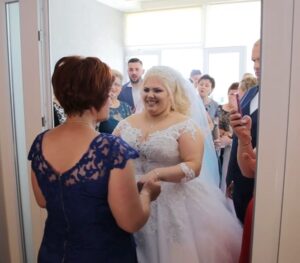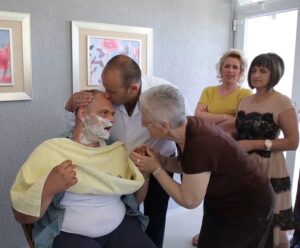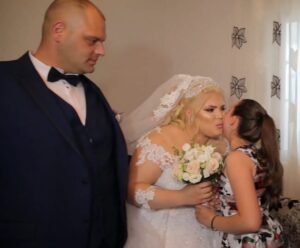Wedding is a very special tradition, preserved and practiced from generation to generation. The scope of activity of this element includes social practices, festive ceremonies, rituals, and verbal habits or skills. When a couple decides to crown their love, several specific rituals follow before and during the wedding to celebrate the forthcoming union. The opening ceremony of the family event is called “shkelkat” (engagement, asking the girl for her hand), which is the prelude of the marriage contract. The boy’s family members visit the girl’s family with “peshqeshe” (gifts) and candy and desserts to cut the deal which marks the couple cleaving to each other. The boy’s family (in-laws) should come in an odd number (7-9 people) which is a symbol of the girl cleaving to her expectant spouse. The girl’s family members pay a visit back to the boy’s house and they come in even numbers (8-10 people), which symbolizes their consent to the engagement bond. The ritual of engagement ensues with deciding on the wedding date. Two weeks before the wedding, “the dowry is brought to the bride’s groom”. “Dowry” is the stuff offered by the groom as a gift of clothing, jewelry, and the like for the bride, the wedding dress included.
The wedding celebration starts on Monday both at the girl’s and the boy’s family, with people taking pleasure in the songs and dances booming out. On Wednesday, chickpea bread is cooked in both families as a symbol of good luck and of starting a new family. On Wednesday, baklava is prepared as a characteristic dessert. On Thursday, two men from the groom’s family bring the bride’s dowry with the wedding dresses and in turn, take away the dowry that the bride has prepared for the soon-to-be spouse’s family. It is a custom that each family hosts their wedding party. At the bride’s family, the wedding party is held on Saturday. The bride gets ready, wears a white dress and in the evening the party commences with her family members and the invites. The feast is accompanied by songs and dances with women singing in most cases which is typical for many families. The wedding is formally opened up by the head of the house the bride’s father, who toasts the day with some words of welcoming, wishing, and thanking the guests for their participation. The bride’s father gets the first dance with his daughter, and so the party is blazed. As tradition has it, by the middle of the wedding party, before midnight, the groom’s wedding guests are invited to the bride’s wedding, together with the groom, and stay for a couple of hours. The bride’s family pays due respect and warmly invites them to share these cheerful moments, and dance with the bride. The bride is dressed in white, while the groom appears in an ordinary suit. The groom’s wedding guests leave the wedding party by midnight. On Sunday, the wedding party goes on with the groom’s family, with the roles reversed. Early in the morning, family members make pancakes for the son who is getting married, and treat the guests. Some men from the family accompany the groom in getting ready for the wedding party, such as having his hair cut and being clean-shaven. They sing songs to the boy while tossing money at him.
Song: Fryu era na i solli, këtë berberin nga Stambolli,
Në e prefsh more berber, bëja faqet me sheqer.
(The blowing wind brought us this barber from Istanbul)
(If you are to cut his hair and shave his beard, please sugar-sweeten his face)
The groom together with his kinsmen drives to the bride’s house to fetch the bride. Upon arrival, the groom and his family men are cordially invited to a separate room from the woman and the bride. After a while, they go to the bride’s room, “darovit” her (give gifts, and money) and the groom puts the ring on her finger. The others put jewelry on the bride as the singing goes on.
Song: Portokalli në dorë, limua në xhep,
Varësen që ta solla, ta mbash me shëndet!
(Orange in hand, lime in pocket)
(May the necklace I put on you, bring good luck!)
Once the time has come for the bride to depart with her own family and is taken out of the house, she breaks a glass of water. One of her family men closest to her escorts the bride up to where she joins the groom. As soon as the couple’s car is about to leave away, the road is traditionally sprinkled with raki, and a shower of rice, candies, and coins right out follows. Upon arrival at the groom’s house, the bride is welcomed amidst a convivial atmosphere with songs and dances. At the doorstep, the bride gets a loaf of chickpea bread and gives it out to the guests and the husband’s family members. The mother-in-law brings a dish of honey for the bride to dip her fingers and paints the door corners, as a symbol of good luck and happy life. The bride puts a coin in her shoe and one of the children in the groom’s house takes off her shoe and grabs the coin. Then the party commences with songs and dances on the groom’s side, with the couple dancing all the while together. Meanwhile, the bride’s own family comes and stays for a couple of hours, enjoy the lively atmosphere, and then leaves.






